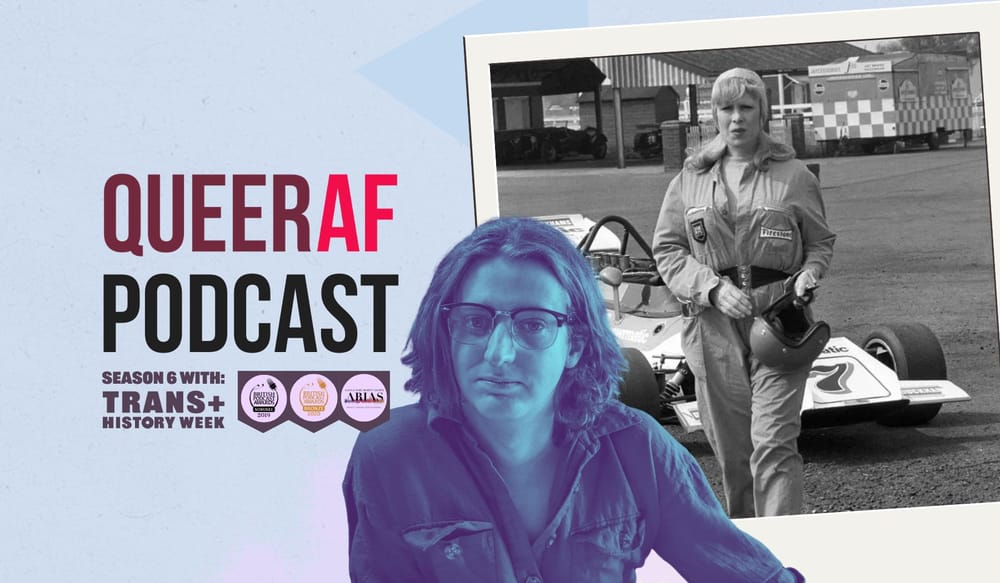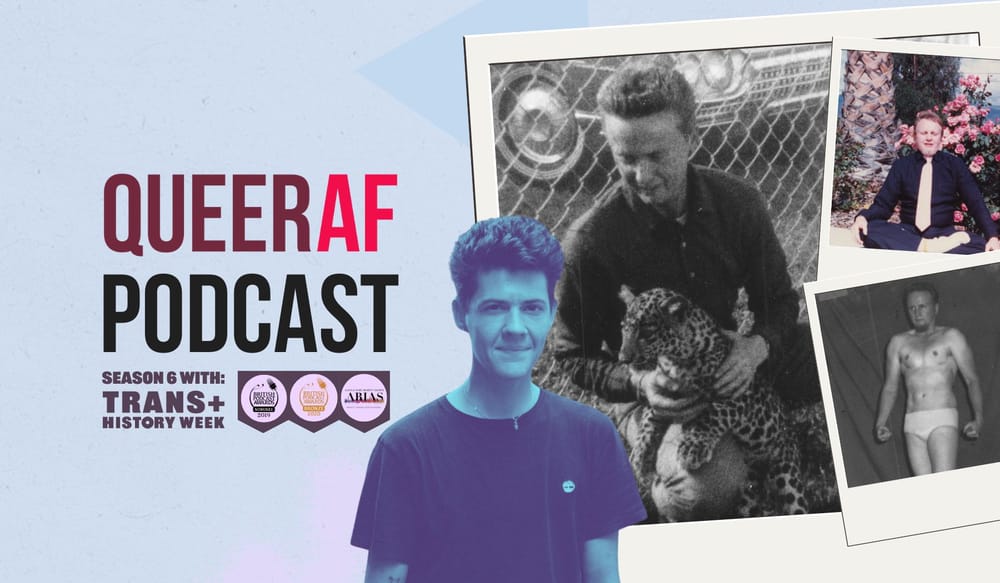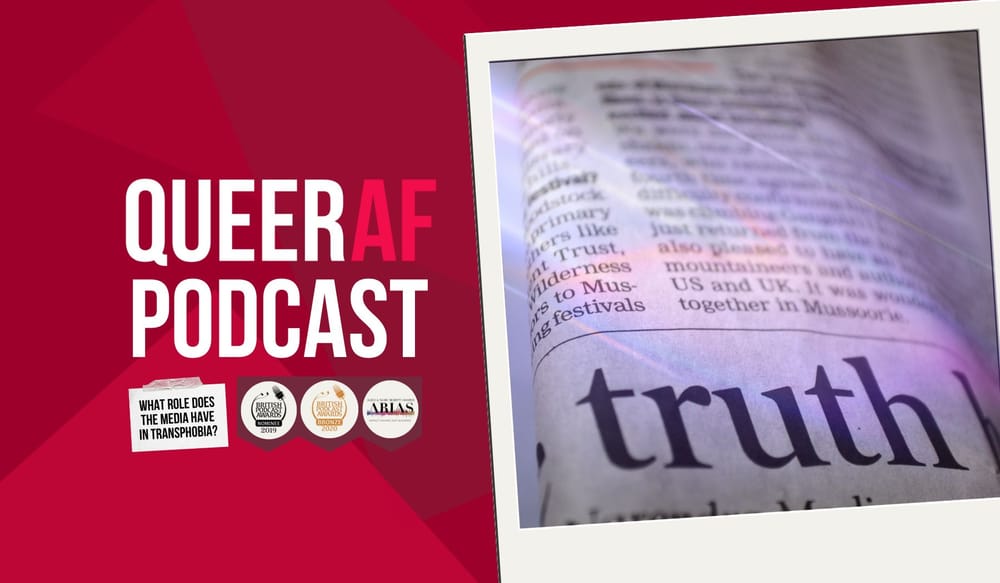
Saint Marinos is remembered for being a monk, who took on and carried the shame of others - despite it's personal implications for himself. Only in death, did his community realise what he'd done for them. But his story is also on, of a refusal to go away: His love, compassion and ability to model the change he wanted to see in the world has a lesson for us all.
For me, Venice is a site of pilgrimage. Located in the Venetian church of Santa Maria Formosa are the relics of the transmasc saint, Marinos the Monk. His dead name is on his coffin, his feminine veil is in a glass case nearby and, as the cherry on top, the electric votive candle rack has not worked any of the times I have visited him.
Despite this, Saint Marinos wears a monk’s habit, his death mask has a masculine haircut and his face is androgynous. His relics proclaim his masculinity for all pilgrims to see.
Raised Catholic, I left the faith after discovering my queerness. However, while suffering from health problems during the pandemic, I dipped my toes back into Catholicism. It was then I first learned about Saint Marinos, medieval Catholic ideas about gender and holiness and how he can be an example.
What began as initially dipping my toes into this history now looks more like wading waist deep into a rich history. It means that now, even though I may not go to mass every Sunday or always remember to abstain from meat on Lenten Fridays, my devotion to Saint Marinos is strong.
Who is Saint Marinos the Monk?
Saint Marinos the Monk’s hagiography (a biography of a saint) has many different variations, but several elements remain consistent. Nicolas Constas’ translation of one of the oldest surviving hagiographies is the most used base text for understanding Marinos’ life.
Saint Marinos lived somewhere in the Byzantine Empire (some sources say Syria, others say Lebanon) during perhaps the 5th Century. It is unclear exactly when and where he lived.
Assigned female at birth, Marinos was raised by two devout parents. Marinos’s mother died while he was still young, and his father Eugenios decided to join a monastery. These were men-only spaces, though, and this decision ultimately meant he had to leave Marinos behind.
Marinos asked, “Father, do you wish to save your own soul and see mine destroyed?” – Life and Conduct of the Blessed translated by Nicolas Constas
Eugenios told Marinos he could not join him because of his sex. Seeing an opportunity to embrace his authentic self and save his soul, Marinos replied, “Not so, my lord, for I shall not enter [the monastery] as you say, but I shall first cut off the hair of my head, and clothe myself like a man, and then enter the monastery with you.”
And so they joined a monastery together, saying Marinos was a eunuch.
As a monk, Marinos thrived. He enacted monastic virtues and asceticism. It is said God granted him the gift to heal possessed people through the laying on of hands.
Exorcising demons is usually associated with men, while possession is associated with women. By giving Marinos this ability, God demonstrates approval towards Marinos' transition and emphasizes the saint’s holiness. – Possessed Politicians? A Short History Of Demon Possession And Exorcism by Sarah Bond
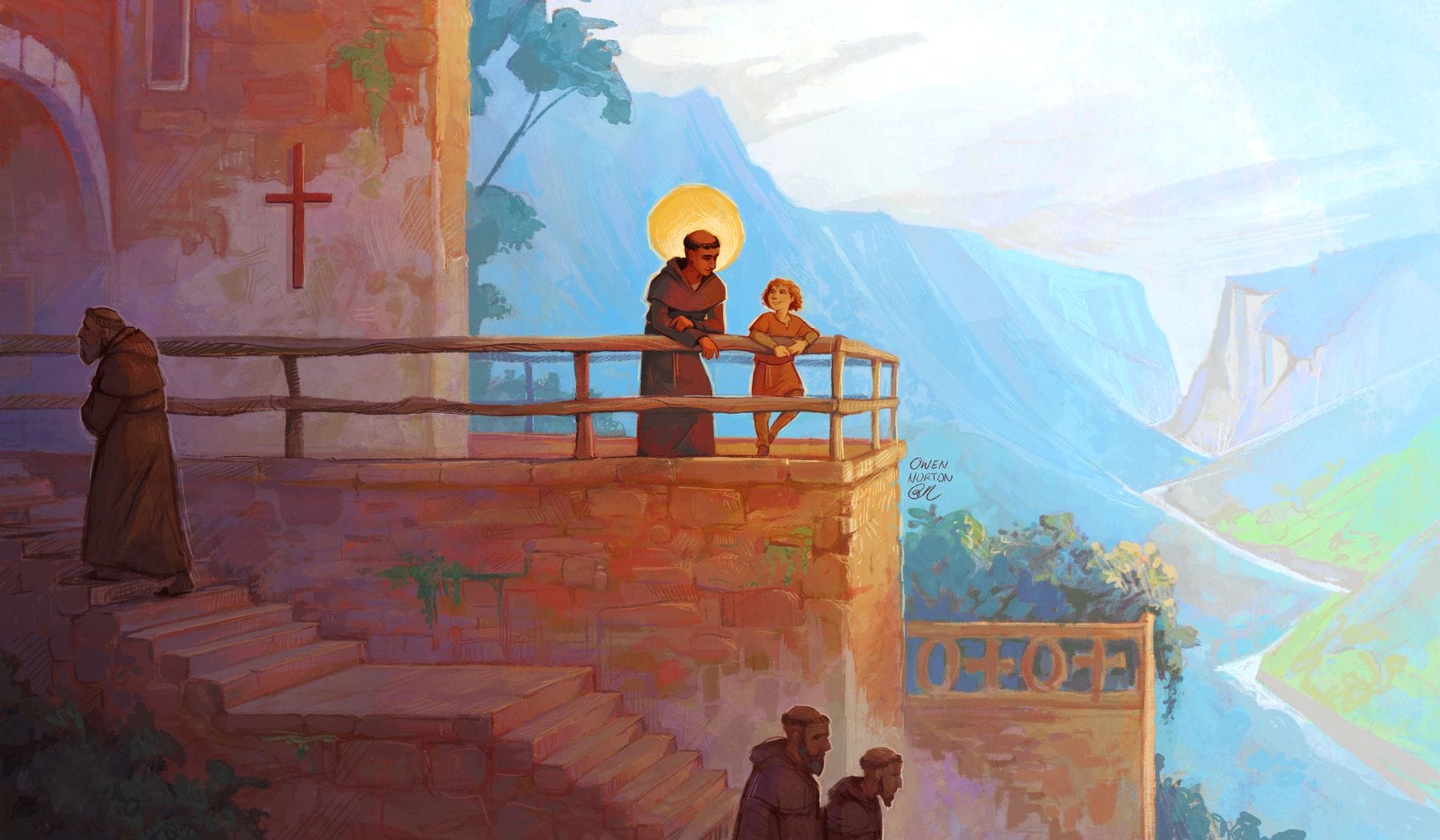
🎨 Artwork description, by Owen Norton
"A digital illustration of Saint Marinos—a medieval transmasc monk—and his foster son in Qannoubine Monastery, overlooking Lebanon’s Kadisha Valley. I was inspired to paint them on-location, sharing a quiet moment above the valley while other monks walk the stone stairs below. Viktor’s article resonated deeply with me as a formerly Christian transmasculine dad. Though Marinos was punished for the circumstances of his son’s birth, they remained part of their faith community—something many queer people are denied today. I hope this collaboration reminds others that queer families have always existed, both within and beyond religion."
Marinos’ holiness and eunuch status made him the ideal man to run errands for the monastery, which would mean travelling and needing to stay outside the Monastery. He and several other monks would stay at the same inn when travelling like this.
At one point, the innkeeper’s daughter got pregnant from an affair with a soldier. To hide this, the soldier told the innkeeper’s daughter to accuse Marinos of being the father.
The innkeeper was, as expected, furious and told his abbot (the monastery’s leader). When the abbot told Marinos the accusations, Marinos “fell upon his face, saying, ‘Forgive me, father, for I have sinned as a man”– Life translated by Nicolas Constas
Trans people have always faced difficult decisions in moments like these and whether or not to detransition in an increasingly hostile modern world. Marinos could have outed himself and gained his innocence, but that would have meant going to a nunnery.
Instead, he chose to remain his authentic self and admitted to a sin he had not committed. For this, the abbot cast Marinos out.
Marinos, refusing to leave entirely, sat by the monastery gate and told guests he had been excommunicated for fornicating. In doing so, Marinos humiliated himself, further demonstrating humility–a monastic virtue–and displaying his secular masculinity. Medieval secular masculinity was partially defined by sexual intercourse versus monastic chastity.
Once the innkeeper’s daughter gave birth, the innkeeper is said to have taken the baby and “threw the child down before” Marinos.
Marinos chose to raise the child, adopting fatherhood and further affirming his masculinity.
For three years, they remained outside the monastery, Marinos telling everyone his sins. Eventually, the other monks begged the abbot to let Marinos back. The abbot relented under the condition Marinos was ‘“the last and least of all.”’ – Life translated by Nicolas Constas
Monasteries are hierarchical institutions, and, after being a monk for so many years, going to the lowest position was an additional punishment. Marinos did every task obediently and without complaint while raising his adopted son. The child grew up to be a monk, too.
Many years later, Marinos did not come to daily services as he normally did. In fact, no one had seen him for a few days. He had died. When they prepared his body for burial, they discovered he couldn’t have fathered any child.
Immediately, the abbot felt guilt. He threw himself at Marinos’ feet and lamented the way he acted. Then “a voice spoke to him saying, “Had you acted knowingly, this sin would not be forgiven you. But since you acted unknowingly, your sin is forgiven.”’
I try to remember Marinos’ words when interacting with non-queer people.
The innkeeper was also told. His now possessed daughter admitted the truth and was eventually healed at Saint Marinos’ tomb – Life translated by Nicolas Constas
What Saint Marinos teaches me about being trans and Catholic
Many in the queer community automatically assume their peers aren’t religious. That’s not necessarily a totally unjustified thought. Religious trauma and queerness often go together like the sky and the sun because of the prejudices that remain in many religions.
For myself though, I choose not to reject Catholicism but embrace it. Saint Marinos has taught me that, despite the Church’s conflicting teachings on gender, I can still live authentically and worship God.
M.W. Bychowski argues Saint Marinos’s hagiography demonstrates the trans desire to live authentically. Marinos could have outed himself when accused of fathering a child. Instead, he chose to live authentically to his spiritual soul instead of his earthly body – The Authentic Lives of Transgender Saints by M.W. Bychowski
His choice shows the essential choice every trans person must make: Do I live as the world sees me or how I know my soul to be? Saint Marinos chose to live authentically despite the hardships he knew he would face.
What can we learn from this history?
It’s important to note the Bible, 4th and 7th Century Church councils and the 5th Century Theodosian code forbade dressing as the opposite sex — Transgender Lives III by Roland Betancourt
Despite this, Saint Marinos and other transmasc saints are venerated, indicating trans people have always had some kind of place in Christianity. This can give other religious queer people hope.–The Amazing Story of Saint Marinos the Monk, Pauline’s Patron Saint of Trans People
Saint Marinos demonstrates that, despite poor treatment by Church officials and secular society, trans people can find ways to quietly resist the wrongs they face, including in ways that make them seen and celebrated in communities that care about them.
Recent anti-trans rhetoric and laws from politicians all over the world, though currently acutely in the US, is trying to eradicate trans people from existence. However, even as Saint Marinos lived in exile outside of his beloved monastery, he was still very visibly there.
Saint Marinos’ example shows one way we can demonstrate our resistance is by being visible. Let’s learn from the Saint and take challenges and difficulties with humility and grace, and of course:
Refuse to go away.
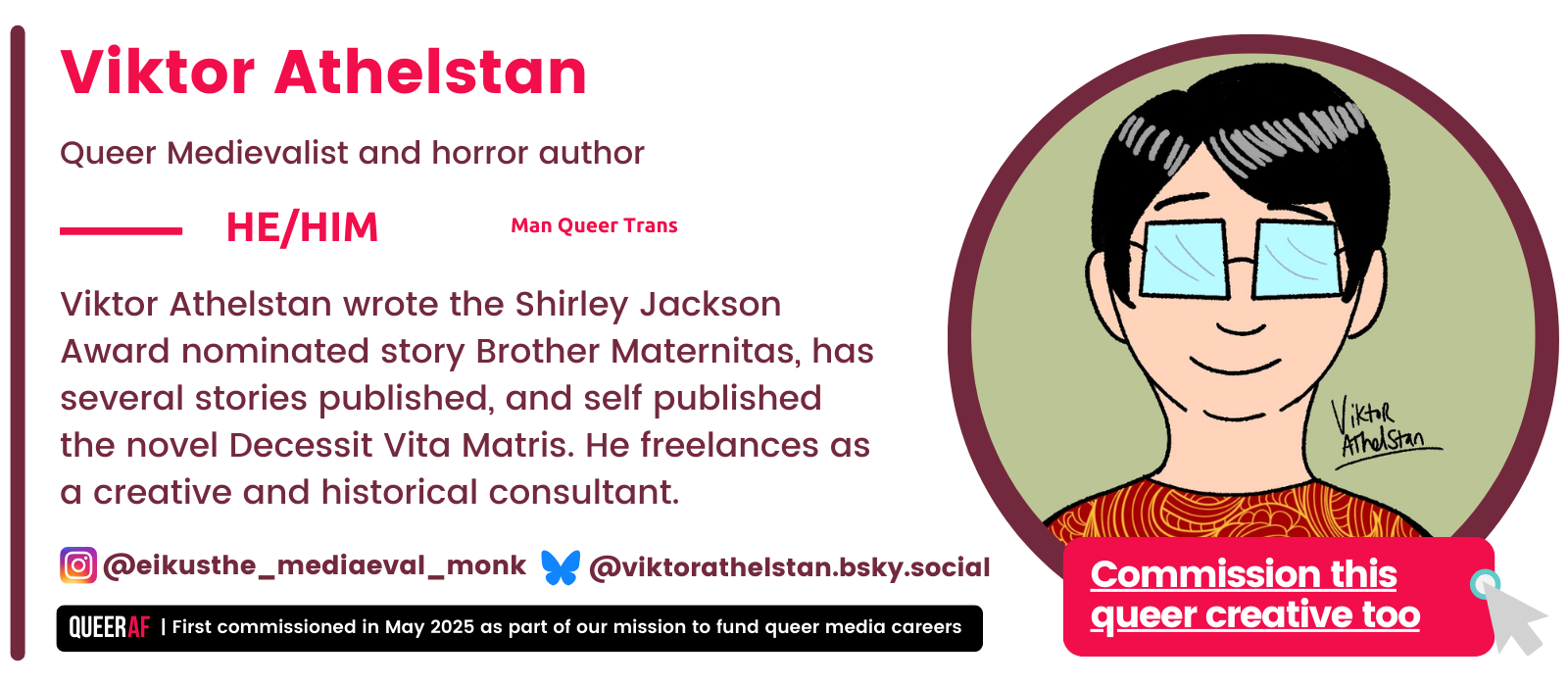
We refuse to go away
The UK has seen a tumultuous few weeks for Trans+ rights. With our own so-called 'equalities watchdog' recommending that organisations segregate Trans+ people with separate toilets in response to a UK Supreme Court ruling.
Speaking to activists here at QueerAF, whether from a legal, political or media background - the call they're uniting around and telling us is: Don't comply.
Or as Saint Marinos shows us - refuse to go away.
This new landscape means a raft of new legal challenges, political fights, and propaganda that needs to be challenged.
We can only win this fight if we all get the information we need to cut through the noise. We need to use nuanced, detailed analysis as the base for our activism.
That's what QueerAF does best. That's why thousands of you read our main newsletter every week. That's why we need you to upgrade today.
Our small but mighty newsletter punches above our weight, but we need you to upgrade to become a paying member so we can accelerate the work we do - and get it in front of as many eyeballs as possible.
The UK is at a critical juncture, and we need your support - so we can help the LGBTQIA+ community navigate through it.
All we're asking for is the price of a coffee a month. If you value the work we do, please take action, and help us fight back against the hate.
We are Queer As Fuck. And so are you.







